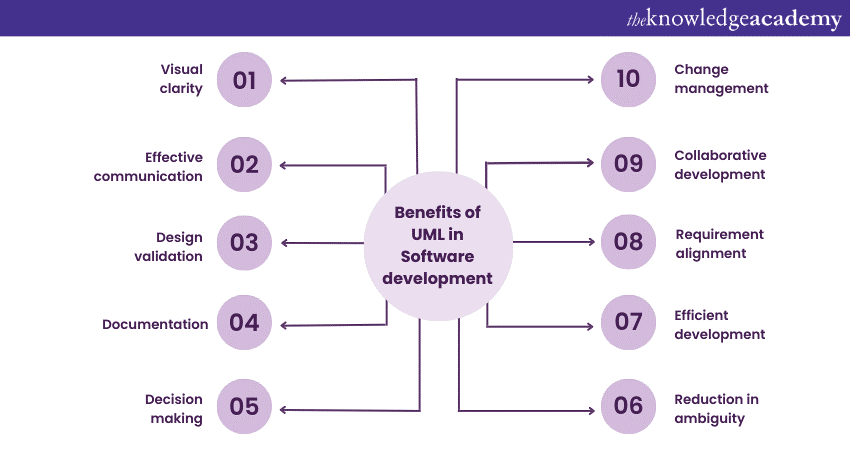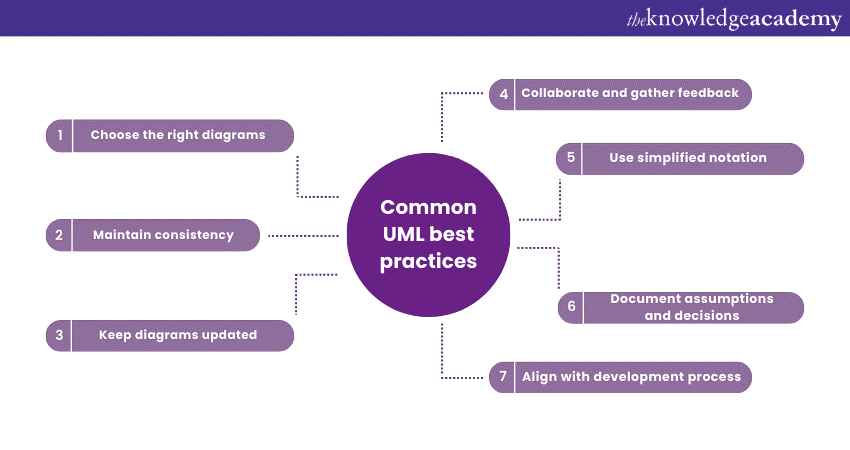We may not have the course you’re looking for. If you enquire or give us a call on +64 98874342 and speak to our training experts, we may still be able to help with your training requirements.
Training Outcomes Within Your Budget!
We ensure quality, budget-alignment, and timely delivery by our expert instructors.

In the world of Software Engineering, effective communication and visualisation of complex systems are crucial for successful project outcomes. Unified Modelling Language (UML) stands as a powerful tool that aids in this endeavour. Understanding “What is UML in Software Engineering?” can help you simplify the visualisation of complex systems and make it easier to represent them.
In this blog, we'll provide an in-depth exploration of “What is UML in Software Engineering?”, its benefits, components, and its role in enhancing Software Development.
Table of Contents
1) The origin of UML
2) Who uses UML?
3) How does UML work?
4) UML in Software Engineering
5) Benefits of UML in Software Development
6) UML tools and adoption
7) Common UML best practices
8) Challenges and limitations of UML
9) Conclusion
The origin of UML
UML has emerged as a universal tool in the field of Software Engineering. It has revolutionised the way software systems are designed, documented, and communicated. UML's roots can be traced back to the 1970s when Software Development was still in its infancy. During this time, the need for a standardised visual language became evident.
As Software Development progressed, Engineers and Computer Scientists started using diagrams like flowcharts and structure charts to illustrate program logic. However, these methods were insufficient for capturing the complexities of modern software systems.
This led to the emergence of methodologies like the Booch method, introduced by Grady Booch, and the Object Modeling Technique (OMT), developed by James Rumbaugh. These methodologies used graphical notations to represent software designs.
These early visualisations were critical steps in the evolution of UML. They laid the groundwork for a unified modeling language that could comprehensively address the intricacies of Software Development. Here are some key milestones in the journey of UML:
1) Early visualisations: The story of UML begins with the advent of structured programming in the 1970s.
2) Emergence of Booch and OMT: In the mid-1980s, Grady Booch introduced the Booch method, while James Rumbaugh developed OMT.
3) Breakthrough moment: The breakthrough came in the mid-1990s when Grady Booch, James Rumbaugh, and Ivar Jacobson joined forces.
4) Evolution and expansion: UML continued to evolve, leading to UML 2.0 in 2005.
Today, UML continues to be an essential tool for Software Engineers, architects, and designers. Its ability to visualise complex systems, enhance communication, and facilitate Software Development has solidified its place in the history and future of Software Engineering.
Who uses UML?
UML is widely used by professionals and organisations across various domains within the field of Software Engineering and Development. The primary users of UML include:
1) Software Developers: Software Developers use UML diagrams to design, model, and communicate the architecture and behaviour of software systems. It helps them visualise complex systems and make informed decisions during the development process.
2) System Architects: System Architects employ UML to create high-level system designs, define system components. It also ensures that the overall system meets the desired requirements and specifications.
3) Project Managers: Project Managers utilise UML diagrams to provide a visual representation of the project's progress, milestones, and dependencies. It aids in project planning, scheduling, and resource allocation.
4) Quality Assurance (QA) and testing teams: Testing teams use UML diagrams to understand system functionalities and develop test cases based on system behaviour models. It ensures comprehensive testing coverage.
5) Business Analysts: Business Analysts employ UML to capture and model business processes, requirements, and use cases. It helps close the gap between business requirements and technical implementation.
6) Documentation and Technical Writers: UML diagrams assist Technical Writers in creating documentation that accurately represents the software's architecture and functionality. This makes it easier for end-users to understand the documentation.
How does UML work?
UML plays a pivotal role in the Software Development process. It serves as a visual language that aids Software Developers in creating effective models and designs for well-functioning systems, streamlining the development process. After developers have written the code, UML diagrams come into play to document various workflows, activities, and role assignments.
UML diagrams consist of elements that are integral to the modelling process. Let's explore some common element notations frequently used in UML modelling:
1) Object: Objects represent real-world entities and serve as the foundational elements in UML. They facilitate the division of large systems into manageable sections, making it easier for developers and engineers to work on them incrementally.
2) Class: Classes define both the structure and function of objects. Objects with similar structures and functions are typically grouped into the same class for organisation and clarity.
3) Abstraction: Abstraction visually represents an object's behaviour and its dependencies on other elements within the diagram. It helps convey the essential characteristics of an object.
4) Inheritance: Inheritance is a technical process that categorises classes of objects or creates new classes based on existing ones. It enables the reuse of code and promotes efficient development.
5) Encapsulation: Encapsulation involves the bundling of data to protect it from unauthorised access or interference. It ensures that data remains secure and only accessible to those with the appropriate permissions.
6) Polymorphism: Polymorphism is a technical concept where entities or functions can operate in a similar manner but undergo different implementation processes. It can occur at various stages during development.
Overall, UML acts as a visual aid that empowers Software Developers to conceptualise, design, and document software systems comprehensively. This enhances the efficiency and effectiveness of the Software Development Life Cycle (SDLC).
UML in Software Engineering
Unified Modelling Language serves as a visual communication tool in Software Engineering. It helps in facilitating the depiction, documentation, and comprehension of intricate system structures and processes. Moreover, it also acts as a bridge between technical complexities and effective communication, enabling seamless collaboration among diverse stakeholders.
UML's diverse diagram types, from structural to behavioural, empower teams to illustrate system architecture, interactions, and workflows. By simplifying complex ideas into visual representations, UML enhances clarity, fosters better decision-making, and supports the entire Software Development Life Cycle.
UML encompasses two essential categories of diagrams: structural and behavioural. These components serve as powerful visual tools that aid in comprehending and representing complex systems. Let’s explore them below:
Structural diagrams
Structural diagrams focus on the static structure of a system, showcasing its components and their relationships.
a) Class diagram: Illustrates classes, attributes, methods, and associations, offering a blueprint of the system's structure.
b) Object diagram: Provides a snapshot of instances in a particular moment, showing how objects relate and interact.
c) Component diagram: Depicts the high-level structure of software components and their dependencies.
d) Deployment diagram: Visualises the physical arrangement of software components on hardware, aiding in system deployment.
Behavioural diagrams
Behavioural diagrams dive into the dynamic aspects of a system, revealing its processes, interactions, and flow of actions.
a) Use case diagram: Captures system functionalities from the user's perspective, depicting interactions between actors and use cases.
b) Sequence diagram: Illustrates the chronological sequence of interactions among objects, uncovering the temporal dynamics of a system.
c) Activity diagram: Offers insights into the workflow and control flow of a system, depicting how activities are coordinated.
d) State machine diagram: Represents the life cycle of objects and their transitions, portraying how objects behave and change over time.
These key components of UML facilitate effective communication, design documentation, and collaborative understanding among stakeholders in the realm of Software Engineering.
Benefits of UML in Software Development
The benefits of UML in Software Development are far-reaching, enhancing communication through visual representation and fostering effective collaboration among diverse stakeholders. UML's ability to provide design clarity and comprehensive documentation elevates project outcomes and streamlines the Software Development Life Cycle. Let’s explore some of the benefits of UML:

a) Visual clarity: UML offers visual representations that simplify complex system structures, making it easier for teams to understand and discuss intricate concepts.
b) Effective communication: UML diagrams provide a common language for technical and non-technical stakeholders, enhancing collaboration and aligning perspectives
c) Design validation: UML helps identify design flaws early by visually representing system components, their relationships, and interactions, ensuring robust and error-free designs.
d) Documentation: UML serves as concise and comprehensive documentation, capturing critical system details for future reference and maintaining a clear historical record.
e) Decision-making: UML diagrams aid in making informed design decisions by visualising trade-offs, alternatives, and impacts of various design choices.
f) Reduction in ambiguity: UML's standardised notation reduces ambiguity in design discussions, preventing misunderstandings and potential errors.
g) Efficient development: UML accelerates the development process by offering clear insights into system architecture, allowing developers to focus on implementation.
h) Requirement alignment: UML's use case diagrams ensure that software functionality aligns with user requirements, enhancing customer satisfaction.
i) Collaborative development: UML fosters collaboration by providing a visual representation that encourages team members to share ideas and insights.
j) Change management: UML diagrams ease the understanding of system changes, making it simpler to assess the impact of modifications and updates.
Unlock the power of UML in Software Engineering with our comprehensive Introduction to UML Training!
UML tools and adoption
The utilisation of UML tools has become essential for effectively translating complex concepts into tangible visual representations. Various UML modelling tools cater to diverse needs, facilitating efficient diagram creation, collaboration, and design refinement.
These tools offer user-friendly interfaces and a wide array of features that streamline the process of creating UML diagrams. Examples of such tools include Enterprise Architect, Visual Paradigm, and LucidChart. Enterprise Architect provides comprehensive UML support with advanced features for in-depth modelling.
Visual Paradigm offers a collaborative environment, enabling teams to create, edit, and share UML diagrams seamlessly. LucidChart, a cloud-based platform, promotes real-time collaboration and accessibility from any device.
The adoption of UML tools enhances communication among project stakeholders, allowing technical and non-technical individuals to engage in meaningful discussions. The visual nature of UML diagrams simplifies the conveyance of intricate ideas, promoting clearer understanding.
Moreover, these tools contribute to better design decisions, streamlined documentation, and effective collaboration, leading to improved Software Development outcomes. As Software Engineering practices continue to evolve, the adoption of UML tools remains instrumental in facilitating successful projects.
Common UML best practices

When utilising UML in Software Engineering, adhering to best practices ensures the clarity, accuracy, and effectiveness of the visual representations. Here are some key best practices to consider:
a) Choose the right diagrams: Select UML diagrams that best suit the communication needs of your project. Different diagrams serve different purposes, so use those that accurately convey the intended information.
b) Maintain consistency: Stick to consistent notation and terminology across all UML diagrams. This prevents confusion and promotes a clear understanding of the system's structure and behaviour.
c) Keep diagrams updated: Regularly update UML diagrams to reflect the current state of the system. Outdated or inaccurate diagrams can lead to misunderstandings and incorrect decisions.
d) Collaborate and gather feedback: Involve relevant stakeholders, including developers, designers, and Business Analysts, in the creation and review of UML diagrams. Their input can help ensure the accuracy and completeness of the representations.
e) Use simplified notation: While UML notation is standardised, strive to keep diagrams simple and intuitive. Avoid overloading diagrams with unnecessary details that could hinder their readability.
f) Document assumptions and decisions: Document any assumptions or design decisions made during the creation of UML diagrams. This provides context and rationale for the choices made.
g) Align with development process: Integrate UML diagrams into your Software Development process. Ensure that they align with the evolving requirements, design decisions, and system architecture.
Elevate your skills with our Agile Software Development Training and embrace the power of iterative and collaborative project success.
Challenges and limitations of UML
While UML is a powerful asset in Software Engineering, it also presents challenges and limitations that developers must navigate to maximise its benefits.
a) Overcomplication: UML diagrams can sometimes become overly intricate, diminishing their intended clarity and effectiveness in conveying complex ideas.
b) Learning curve: Understanding UML notation and concepts can pose a steep learning curve for newcomers to Software Engineering. This can potentially slow down the adoption of UML practices.
c) Maintenance burden: Keeping UML diagrams up to date can be challenging, especially in rapidly evolving projects. Outdated diagrams can lead to confusion among developers and stakeholders.
d) Representation gap: While UML is a valuable communication tool, it might struggle to fully capture certain dynamic aspects of software systems, potentially leaving gaps in understanding.
e) Ambiguity: Interpretation of UML diagrams can vary among different team members or stakeholders, leading to misunderstandings and misaligned expectations.
f) Lack of consistency: In large teams or across different projects, maintaining consistency in UML diagram notations and practices can be difficult, resulting in confusion.
g) Not suitable for all projects: UML might not be the best fit for all types of projects, particularly small-scale or rapidly prototyped ones, where the overhead of creating and maintaining UML diagrams might not be justified.
h) Tool dependency: Effective usage of UML often requires familiarity with specific UML modelling tools, potentially creating a dependency on those tools and limiting the flexibility of diagram sharing and collaboration.
Conclusion
We hope you read and understood “What is UML in Software Engineering?” UML's visual prowess empowers effective communication, design clarity, and documentation, bolstering collaboration and project success. As technology advances, UML continues to stand strong, guiding developers towards optimal solutions.
Unlock your potential in software engineering with our comprehensive Software Engineering Training.
Frequently Asked Questions

No, UML can also be applied to various fields, like System Engineering, Business Modelling, and more, to visually represent and analyse complex systems and processes. Its versatility makes it a valuable tool for cross-disciplinary applications, enhancing understanding and communication.

Yes, UML can model real-time systems, offering tools like sequence diagrams and state machine diagrams to represent time-sensitive processes and behaviours accurately. Its adaptability extends its utility to diverse domains, making it a comprehensive choice for system modelling and design.

The Knowledge Academy takes global learning to new heights, offering over 30,000 online courses across 490+ locations in 220 countries. This expansive reach ensures accessibility and convenience for learners worldwide.
Alongside our diverse Online Course Catalogue, encompassing 17 major categories, we go the extra mile by providing a plethora of free educational Online Resources like News updates, Blogs, videos, webinars, and interview questions. By tailoring learning experiences further, professionals can maximise value with customisable Course Bundles of TKA.

The Knowledge Academy’s Knowledge Pass, a prepaid voucher, adds another layer of flexibility, allowing course bookings over a 12-month period. Join us on a journey where education knows no bounds.

The Knowledge Academy offers various UML Courses, including Introduction to UML Training and Analysis & Design using UML. These courses cater to different skill levels, providing comprehensive insights into Programming & DevOps methodologies.
Our Programming & DevOps Blogs cover a range of topics related to UML, offering valuable resources, best practices, and industry insights. Whether you are a beginner or looking to advance your Software Engineering skills, The Knowledge Academy's diverse courses and informative blogs have you covered.
Upcoming Programming & DevOps Resources Batches & Dates
Date
 Systems Engineering Training
Systems Engineering Training
Fri 29th Nov 2024
Fri 3rd Jan 2025
Fri 28th Mar 2025
Fri 23rd May 2025
Fri 4th Jul 2025
Fri 5th Sep 2025
Fri 24th Oct 2025







 Top Rated Course
Top Rated Course



 If you wish to make any changes to your course, please
If you wish to make any changes to your course, please


